Impact of Attractiveness Perception: A Social Psychology Study
VerifiedAdded on 2021/01/01
|14
|3965
|484
Report
AI Summary
This report details a social psychology experiment investigating the halo effect, specifically examining how perceived attractiveness influences judgments of others. The study employs a quantitative methodology, utilizing statistical software to analyze data collected from 31 female participants. The research includes a comprehensive literature review on social psychology theories like attribution theory, cognitive dissonance, and drive theory, as well as the concept of the halo effect. The methodology section outlines the use of questionnaires and purposive sampling to gather data on participants' perceptions of individuals in pictures. Statistical analyses, including ANOVA, correlation, mean, and standard deviation calculations, are employed to interpret the results. The findings reveal correlations between attractiveness and various traits, such as intelligence and competence, highlighting the impact of the halo effect in shaping perceptions. The report concludes with a discussion of the results and their implications, along with references to relevant academic sources.
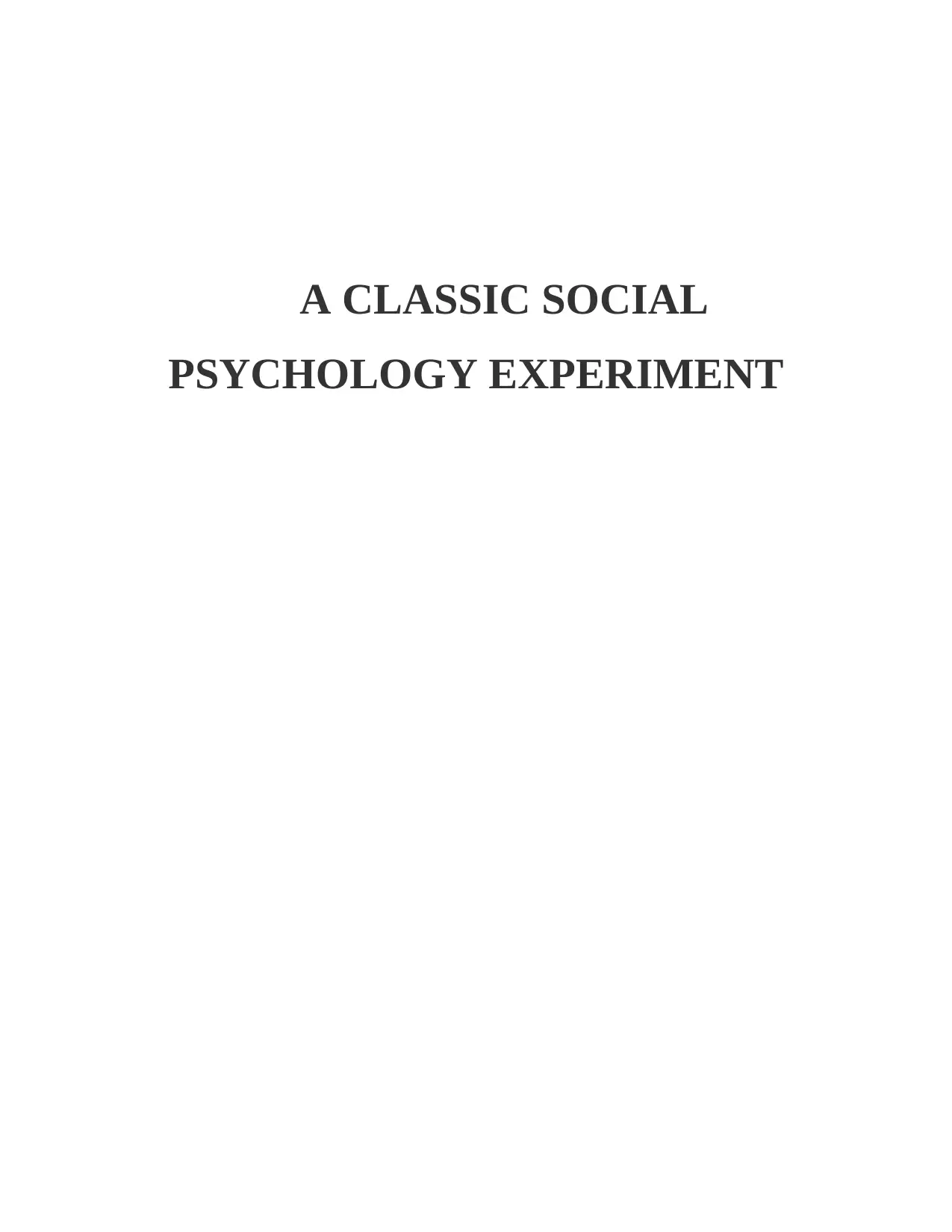
A CLASSIC SOCIAL
PSYCHOLOGY EXPERIMENT
PSYCHOLOGY EXPERIMENT
Paraphrase This Document
Need a fresh take? Get an instant paraphrase of this document with our AI Paraphraser
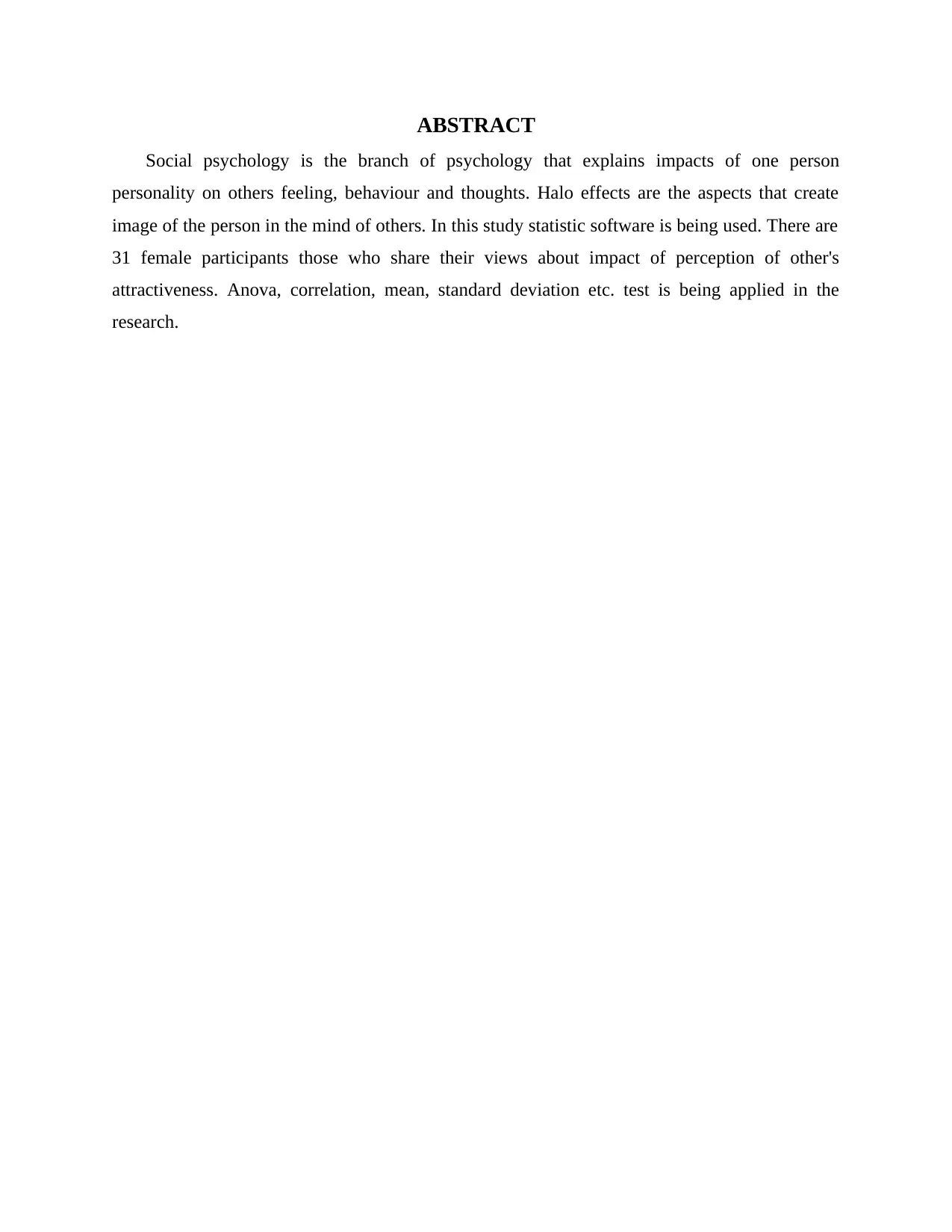
ABSTRACT
Social psychology is the branch of psychology that explains impacts of one person
personality on others feeling, behaviour and thoughts. Halo effects are the aspects that create
image of the person in the mind of others. In this study statistic software is being used. There are
31 female participants those who share their views about impact of perception of other's
attractiveness. Anova, correlation, mean, standard deviation etc. test is being applied in the
research.
Social psychology is the branch of psychology that explains impacts of one person
personality on others feeling, behaviour and thoughts. Halo effects are the aspects that create
image of the person in the mind of others. In this study statistic software is being used. There are
31 female participants those who share their views about impact of perception of other's
attractiveness. Anova, correlation, mean, standard deviation etc. test is being applied in the
research.
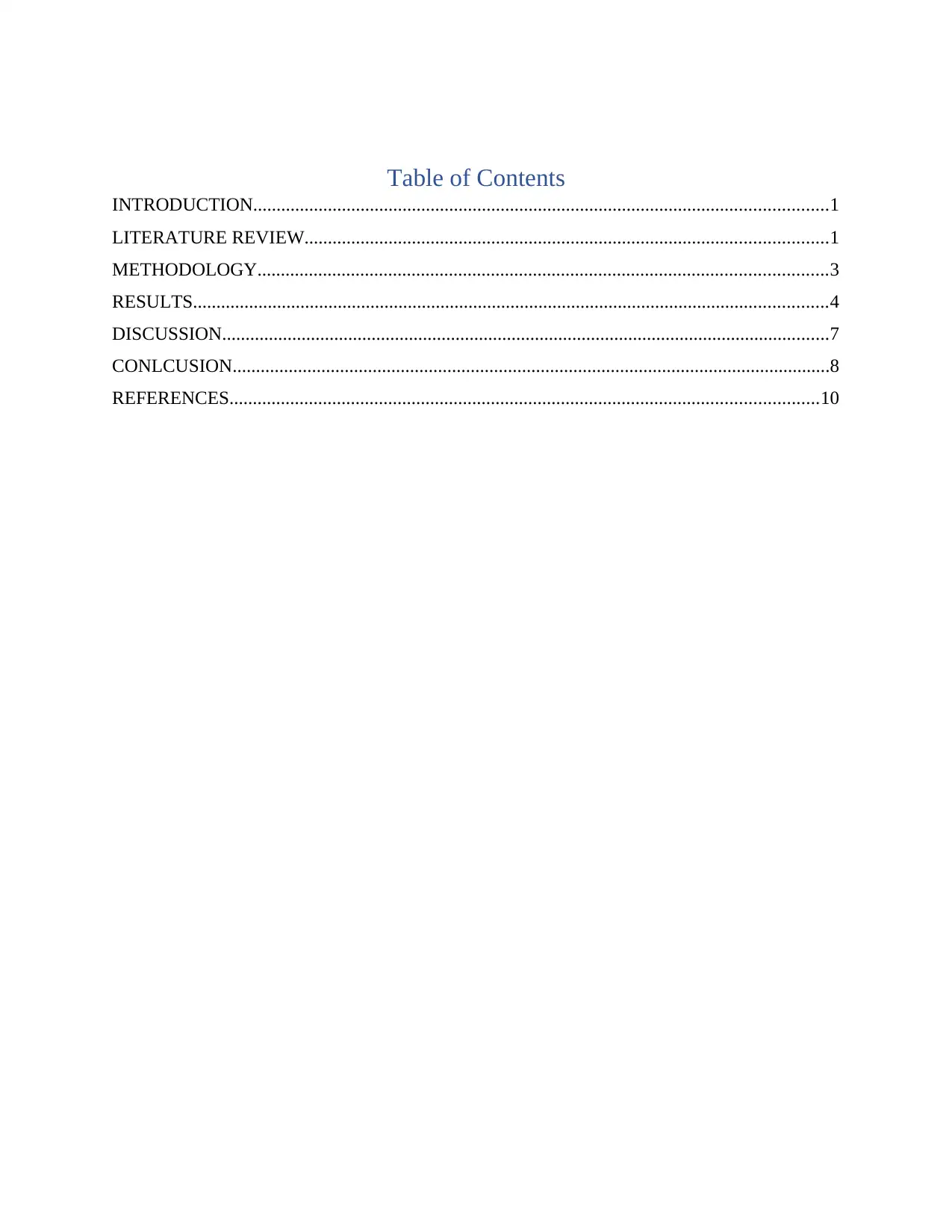
Table of Contents
INTRODUCTION...........................................................................................................................1
LITERATURE REVIEW................................................................................................................1
METHODOLOGY..........................................................................................................................3
RESULTS........................................................................................................................................4
DISCUSSION..................................................................................................................................7
CONLCUSION................................................................................................................................8
REFERENCES..............................................................................................................................10
INTRODUCTION...........................................................................................................................1
LITERATURE REVIEW................................................................................................................1
METHODOLOGY..........................................................................................................................3
RESULTS........................................................................................................................................4
DISCUSSION..................................................................................................................................7
CONLCUSION................................................................................................................................8
REFERENCES..............................................................................................................................10
⊘ This is a preview!⊘
Do you want full access?
Subscribe today to unlock all pages.

Trusted by 1+ million students worldwide
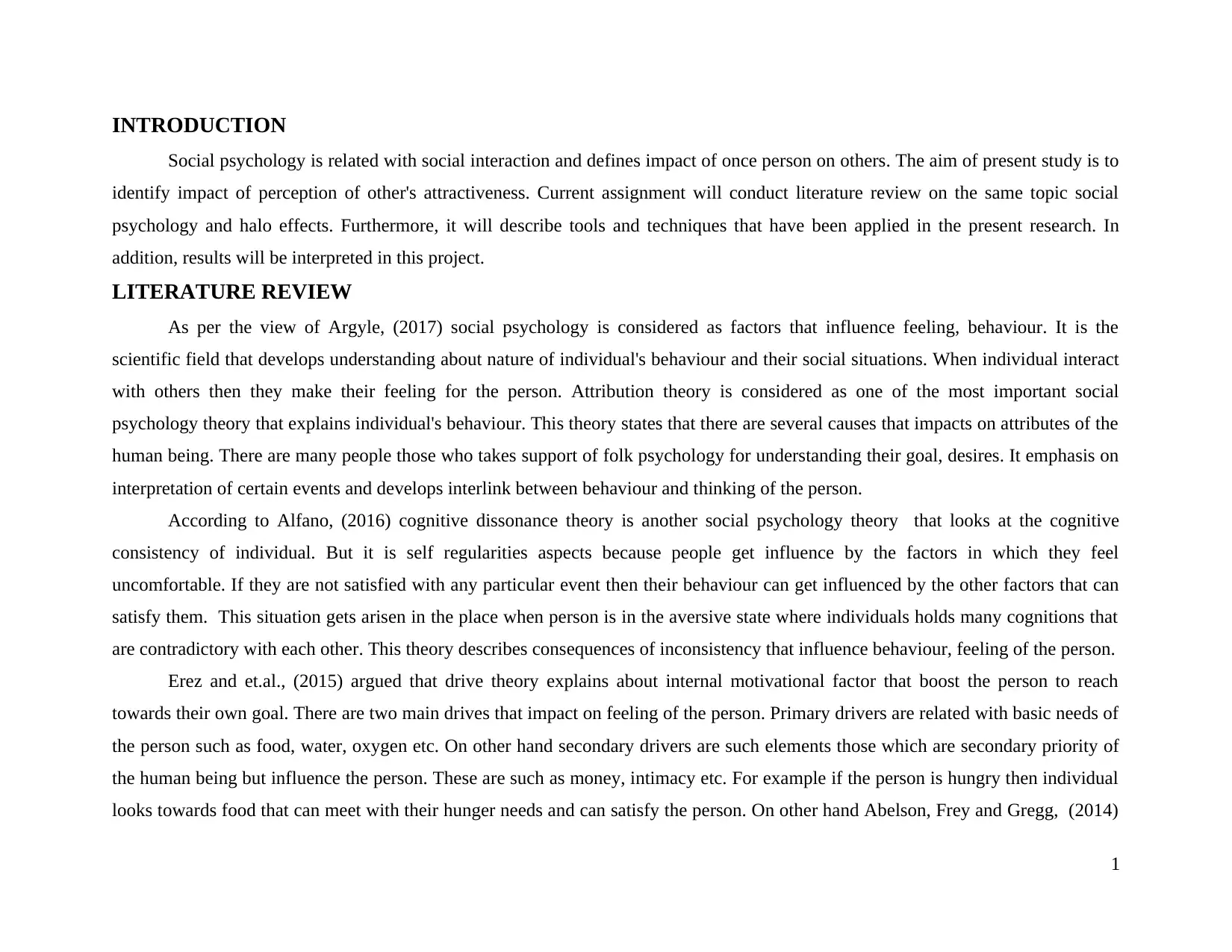
INTRODUCTION
Social psychology is related with social interaction and defines impact of once person on others. The aim of present study is to
identify impact of perception of other's attractiveness. Current assignment will conduct literature review on the same topic social
psychology and halo effects. Furthermore, it will describe tools and techniques that have been applied in the present research. In
addition, results will be interpreted in this project.
LITERATURE REVIEW
As per the view of Argyle, (2017) social psychology is considered as factors that influence feeling, behaviour. It is the
scientific field that develops understanding about nature of individual's behaviour and their social situations. When individual interact
with others then they make their feeling for the person. Attribution theory is considered as one of the most important social
psychology theory that explains individual's behaviour. This theory states that there are several causes that impacts on attributes of the
human being. There are many people those who takes support of folk psychology for understanding their goal, desires. It emphasis on
interpretation of certain events and develops interlink between behaviour and thinking of the person.
According to Alfano, (2016) cognitive dissonance theory is another social psychology theory that looks at the cognitive
consistency of individual. But it is self regularities aspects because people get influence by the factors in which they feel
uncomfortable. If they are not satisfied with any particular event then their behaviour can get influenced by the other factors that can
satisfy them. This situation gets arisen in the place when person is in the aversive state where individuals holds many cognitions that
are contradictory with each other. This theory describes consequences of inconsistency that influence behaviour, feeling of the person.
Erez and et.al., (2015) argued that drive theory explains about internal motivational factor that boost the person to reach
towards their own goal. There are two main drives that impact on feeling of the person. Primary drivers are related with basic needs of
the person such as food, water, oxygen etc. On other hand secondary drivers are such elements those which are secondary priority of
the human being but influence the person. These are such as money, intimacy etc. For example if the person is hungry then individual
looks towards food that can meet with their hunger needs and can satisfy the person. On other hand Abelson, Frey and Gregg, (2014)
1
Social psychology is related with social interaction and defines impact of once person on others. The aim of present study is to
identify impact of perception of other's attractiveness. Current assignment will conduct literature review on the same topic social
psychology and halo effects. Furthermore, it will describe tools and techniques that have been applied in the present research. In
addition, results will be interpreted in this project.
LITERATURE REVIEW
As per the view of Argyle, (2017) social psychology is considered as factors that influence feeling, behaviour. It is the
scientific field that develops understanding about nature of individual's behaviour and their social situations. When individual interact
with others then they make their feeling for the person. Attribution theory is considered as one of the most important social
psychology theory that explains individual's behaviour. This theory states that there are several causes that impacts on attributes of the
human being. There are many people those who takes support of folk psychology for understanding their goal, desires. It emphasis on
interpretation of certain events and develops interlink between behaviour and thinking of the person.
According to Alfano, (2016) cognitive dissonance theory is another social psychology theory that looks at the cognitive
consistency of individual. But it is self regularities aspects because people get influence by the factors in which they feel
uncomfortable. If they are not satisfied with any particular event then their behaviour can get influenced by the other factors that can
satisfy them. This situation gets arisen in the place when person is in the aversive state where individuals holds many cognitions that
are contradictory with each other. This theory describes consequences of inconsistency that influence behaviour, feeling of the person.
Erez and et.al., (2015) argued that drive theory explains about internal motivational factor that boost the person to reach
towards their own goal. There are two main drives that impact on feeling of the person. Primary drivers are related with basic needs of
the person such as food, water, oxygen etc. On other hand secondary drivers are such elements those which are secondary priority of
the human being but influence the person. These are such as money, intimacy etc. For example if the person is hungry then individual
looks towards food that can meet with their hunger needs and can satisfy the person. On other hand Abelson, Frey and Gregg, (2014)
1
Paraphrase This Document
Need a fresh take? Get an instant paraphrase of this document with our AI Paraphraser
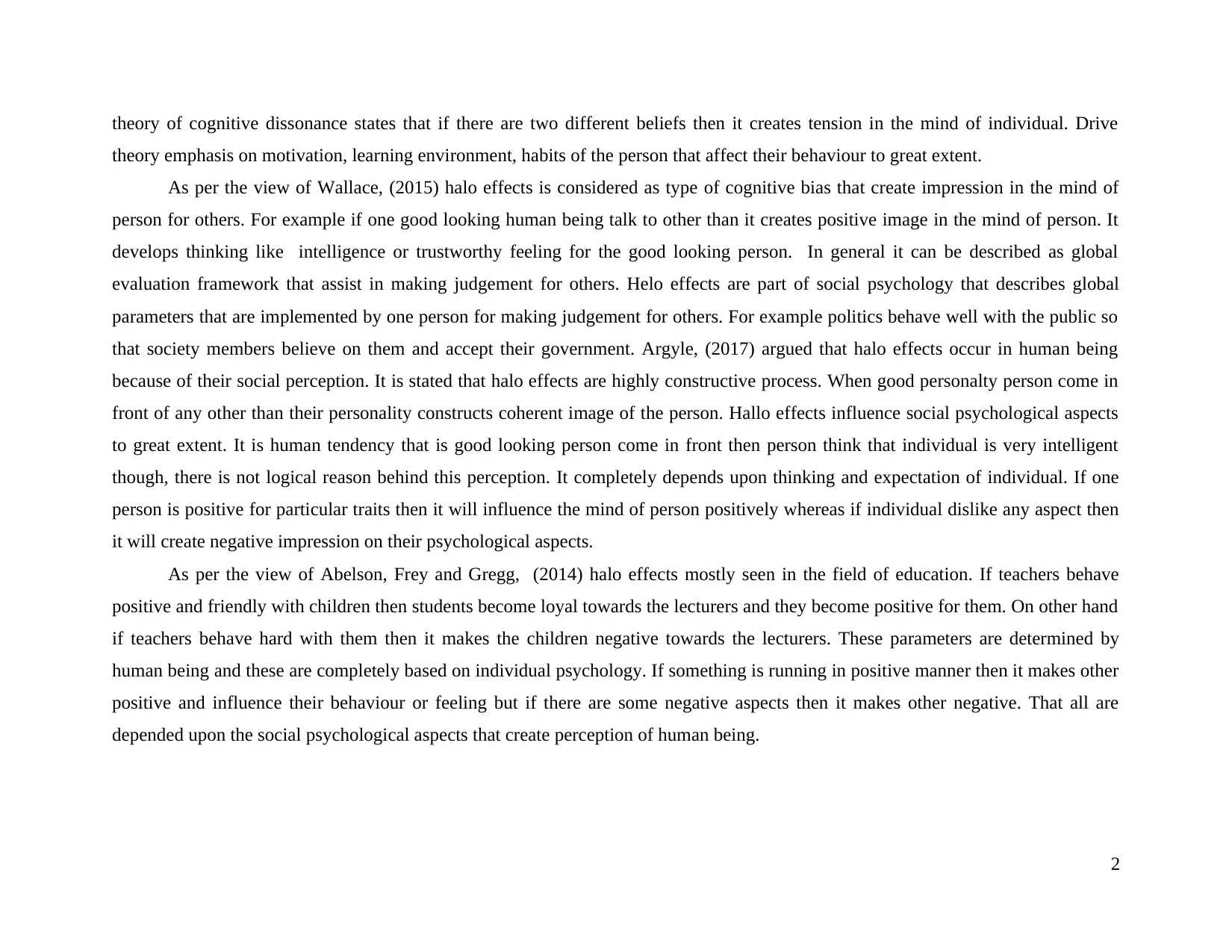
theory of cognitive dissonance states that if there are two different beliefs then it creates tension in the mind of individual. Drive
theory emphasis on motivation, learning environment, habits of the person that affect their behaviour to great extent.
As per the view of Wallace, (2015) halo effects is considered as type of cognitive bias that create impression in the mind of
person for others. For example if one good looking human being talk to other than it creates positive image in the mind of person. It
develops thinking like intelligence or trustworthy feeling for the good looking person. In general it can be described as global
evaluation framework that assist in making judgement for others. Helo effects are part of social psychology that describes global
parameters that are implemented by one person for making judgement for others. For example politics behave well with the public so
that society members believe on them and accept their government. Argyle, (2017) argued that halo effects occur in human being
because of their social perception. It is stated that halo effects are highly constructive process. When good personalty person come in
front of any other than their personality constructs coherent image of the person. Hallo effects influence social psychological aspects
to great extent. It is human tendency that is good looking person come in front then person think that individual is very intelligent
though, there is not logical reason behind this perception. It completely depends upon thinking and expectation of individual. If one
person is positive for particular traits then it will influence the mind of person positively whereas if individual dislike any aspect then
it will create negative impression on their psychological aspects.
As per the view of Abelson, Frey and Gregg, (2014) halo effects mostly seen in the field of education. If teachers behave
positive and friendly with children then students become loyal towards the lecturers and they become positive for them. On other hand
if teachers behave hard with them then it makes the children negative towards the lecturers. These parameters are determined by
human being and these are completely based on individual psychology. If something is running in positive manner then it makes other
positive and influence their behaviour or feeling but if there are some negative aspects then it makes other negative. That all are
depended upon the social psychological aspects that create perception of human being.
2
theory emphasis on motivation, learning environment, habits of the person that affect their behaviour to great extent.
As per the view of Wallace, (2015) halo effects is considered as type of cognitive bias that create impression in the mind of
person for others. For example if one good looking human being talk to other than it creates positive image in the mind of person. It
develops thinking like intelligence or trustworthy feeling for the good looking person. In general it can be described as global
evaluation framework that assist in making judgement for others. Helo effects are part of social psychology that describes global
parameters that are implemented by one person for making judgement for others. For example politics behave well with the public so
that society members believe on them and accept their government. Argyle, (2017) argued that halo effects occur in human being
because of their social perception. It is stated that halo effects are highly constructive process. When good personalty person come in
front of any other than their personality constructs coherent image of the person. Hallo effects influence social psychological aspects
to great extent. It is human tendency that is good looking person come in front then person think that individual is very intelligent
though, there is not logical reason behind this perception. It completely depends upon thinking and expectation of individual. If one
person is positive for particular traits then it will influence the mind of person positively whereas if individual dislike any aspect then
it will create negative impression on their psychological aspects.
As per the view of Abelson, Frey and Gregg, (2014) halo effects mostly seen in the field of education. If teachers behave
positive and friendly with children then students become loyal towards the lecturers and they become positive for them. On other hand
if teachers behave hard with them then it makes the children negative towards the lecturers. These parameters are determined by
human being and these are completely based on individual psychology. If something is running in positive manner then it makes other
positive and influence their behaviour or feeling but if there are some negative aspects then it makes other negative. That all are
depended upon the social psychological aspects that create perception of human being.
2
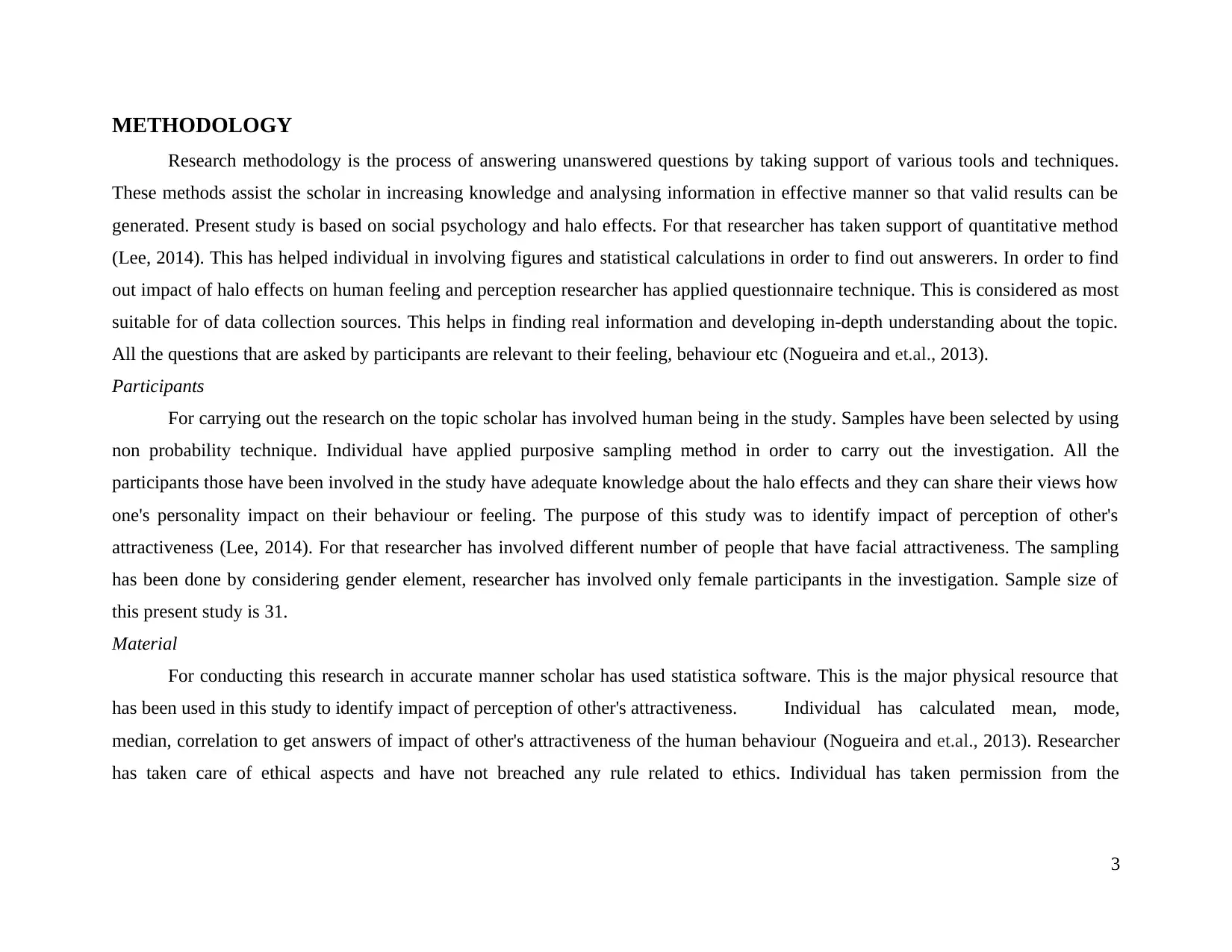
METHODOLOGY
Research methodology is the process of answering unanswered questions by taking support of various tools and techniques.
These methods assist the scholar in increasing knowledge and analysing information in effective manner so that valid results can be
generated. Present study is based on social psychology and halo effects. For that researcher has taken support of quantitative method
(Lee, 2014). This has helped individual in involving figures and statistical calculations in order to find out answerers. In order to find
out impact of halo effects on human feeling and perception researcher has applied questionnaire technique. This is considered as most
suitable for of data collection sources. This helps in finding real information and developing in-depth understanding about the topic.
All the questions that are asked by participants are relevant to their feeling, behaviour etc (Nogueira and et.al., 2013).
Participants
For carrying out the research on the topic scholar has involved human being in the study. Samples have been selected by using
non probability technique. Individual have applied purposive sampling method in order to carry out the investigation. All the
participants those have been involved in the study have adequate knowledge about the halo effects and they can share their views how
one's personality impact on their behaviour or feeling. The purpose of this study was to identify impact of perception of other's
attractiveness (Lee, 2014). For that researcher has involved different number of people that have facial attractiveness. The sampling
has been done by considering gender element, researcher has involved only female participants in the investigation. Sample size of
this present study is 31.
Material
For conducting this research in accurate manner scholar has used statistica software. This is the major physical resource that
has been used in this study to identify impact of perception of other's attractiveness. Individual has calculated mean, mode,
median, correlation to get answers of impact of other's attractiveness of the human behaviour (Nogueira and et.al., 2013). Researcher
has taken care of ethical aspects and have not breached any rule related to ethics. Individual has taken permission from the
3
Research methodology is the process of answering unanswered questions by taking support of various tools and techniques.
These methods assist the scholar in increasing knowledge and analysing information in effective manner so that valid results can be
generated. Present study is based on social psychology and halo effects. For that researcher has taken support of quantitative method
(Lee, 2014). This has helped individual in involving figures and statistical calculations in order to find out answerers. In order to find
out impact of halo effects on human feeling and perception researcher has applied questionnaire technique. This is considered as most
suitable for of data collection sources. This helps in finding real information and developing in-depth understanding about the topic.
All the questions that are asked by participants are relevant to their feeling, behaviour etc (Nogueira and et.al., 2013).
Participants
For carrying out the research on the topic scholar has involved human being in the study. Samples have been selected by using
non probability technique. Individual have applied purposive sampling method in order to carry out the investigation. All the
participants those have been involved in the study have adequate knowledge about the halo effects and they can share their views how
one's personality impact on their behaviour or feeling. The purpose of this study was to identify impact of perception of other's
attractiveness (Lee, 2014). For that researcher has involved different number of people that have facial attractiveness. The sampling
has been done by considering gender element, researcher has involved only female participants in the investigation. Sample size of
this present study is 31.
Material
For conducting this research in accurate manner scholar has used statistica software. This is the major physical resource that
has been used in this study to identify impact of perception of other's attractiveness. Individual has calculated mean, mode,
median, correlation to get answers of impact of other's attractiveness of the human behaviour (Nogueira and et.al., 2013). Researcher
has taken care of ethical aspects and have not breached any rule related to ethics. Individual has taken permission from the
3
⊘ This is a preview!⊘
Do you want full access?
Subscribe today to unlock all pages.

Trusted by 1+ million students worldwide
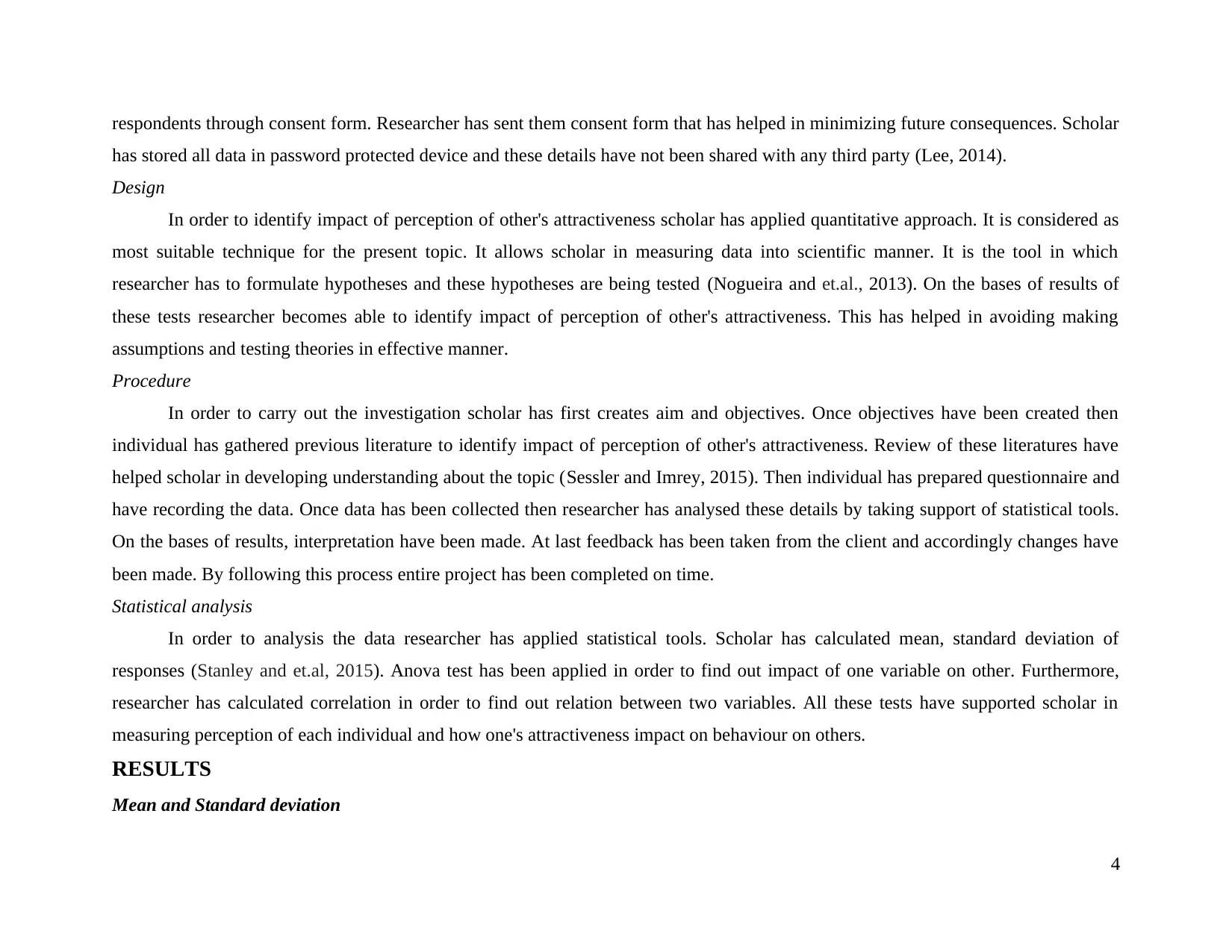
respondents through consent form. Researcher has sent them consent form that has helped in minimizing future consequences. Scholar
has stored all data in password protected device and these details have not been shared with any third party (Lee, 2014).
Design
In order to identify impact of perception of other's attractiveness scholar has applied quantitative approach. It is considered as
most suitable technique for the present topic. It allows scholar in measuring data into scientific manner. It is the tool in which
researcher has to formulate hypotheses and these hypotheses are being tested (Nogueira and et.al., 2013). On the bases of results of
these tests researcher becomes able to identify impact of perception of other's attractiveness. This has helped in avoiding making
assumptions and testing theories in effective manner.
Procedure
In order to carry out the investigation scholar has first creates aim and objectives. Once objectives have been created then
individual has gathered previous literature to identify impact of perception of other's attractiveness. Review of these literatures have
helped scholar in developing understanding about the topic (Sessler and Imrey, 2015). Then individual has prepared questionnaire and
have recording the data. Once data has been collected then researcher has analysed these details by taking support of statistical tools.
On the bases of results, interpretation have been made. At last feedback has been taken from the client and accordingly changes have
been made. By following this process entire project has been completed on time.
Statistical analysis
In order to analysis the data researcher has applied statistical tools. Scholar has calculated mean, standard deviation of
responses (Stanley and et.al, 2015). Anova test has been applied in order to find out impact of one variable on other. Furthermore,
researcher has calculated correlation in order to find out relation between two variables. All these tests have supported scholar in
measuring perception of each individual and how one's attractiveness impact on behaviour on others.
RESULTS
Mean and Standard deviation
4
has stored all data in password protected device and these details have not been shared with any third party (Lee, 2014).
Design
In order to identify impact of perception of other's attractiveness scholar has applied quantitative approach. It is considered as
most suitable technique for the present topic. It allows scholar in measuring data into scientific manner. It is the tool in which
researcher has to formulate hypotheses and these hypotheses are being tested (Nogueira and et.al., 2013). On the bases of results of
these tests researcher becomes able to identify impact of perception of other's attractiveness. This has helped in avoiding making
assumptions and testing theories in effective manner.
Procedure
In order to carry out the investigation scholar has first creates aim and objectives. Once objectives have been created then
individual has gathered previous literature to identify impact of perception of other's attractiveness. Review of these literatures have
helped scholar in developing understanding about the topic (Sessler and Imrey, 2015). Then individual has prepared questionnaire and
have recording the data. Once data has been collected then researcher has analysed these details by taking support of statistical tools.
On the bases of results, interpretation have been made. At last feedback has been taken from the client and accordingly changes have
been made. By following this process entire project has been completed on time.
Statistical analysis
In order to analysis the data researcher has applied statistical tools. Scholar has calculated mean, standard deviation of
responses (Stanley and et.al, 2015). Anova test has been applied in order to find out impact of one variable on other. Furthermore,
researcher has calculated correlation in order to find out relation between two variables. All these tests have supported scholar in
measuring perception of each individual and how one's attractiveness impact on behaviour on others.
RESULTS
Mean and Standard deviation
4
Paraphrase This Document
Need a fresh take? Get an instant paraphrase of this document with our AI Paraphraser
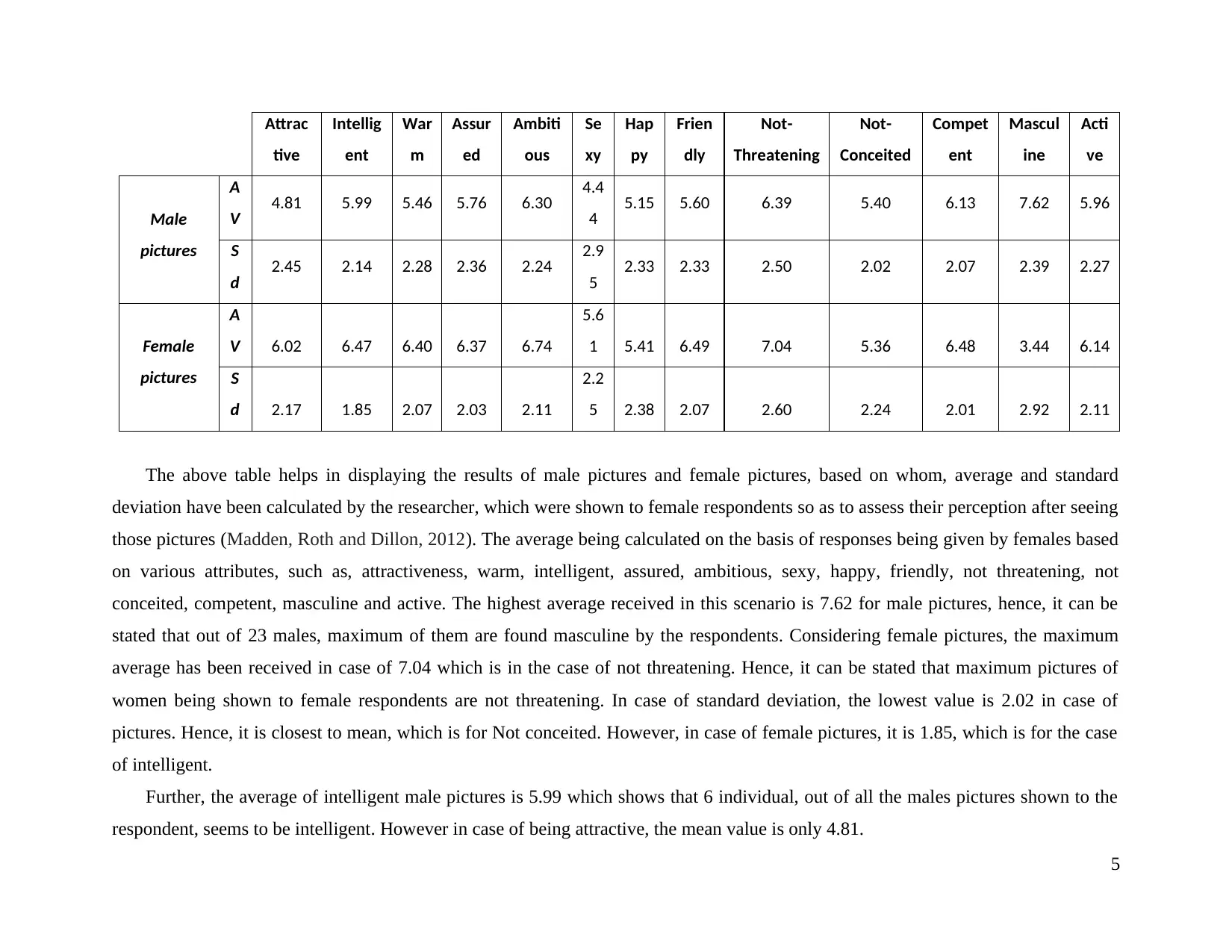
Attrac
tive
Intellig
ent
War
m
Assur
ed
Ambiti
ous
Se
xy
Hap
py
Frien
dly
Not-
Threatening
Not-
Conceited
Compet
ent
Mascul
ine
Acti
ve
Male
pictures
A
V 4.81 5.99 5.46 5.76 6.30 4.4
4 5.15 5.60 6.39 5.40 6.13 7.62 5.96
S
d 2.45 2.14 2.28 2.36 2.24 2.9
5 2.33 2.33 2.50 2.02 2.07 2.39 2.27
Female
pictures
A
V 6.02 6.47 6.40 6.37 6.74
5.6
1 5.41 6.49 7.04 5.36 6.48 3.44 6.14
S
d 2.17 1.85 2.07 2.03 2.11
2.2
5 2.38 2.07 2.60 2.24 2.01 2.92 2.11
The above table helps in displaying the results of male pictures and female pictures, based on whom, average and standard
deviation have been calculated by the researcher, which were shown to female respondents so as to assess their perception after seeing
those pictures (Madden, Roth and Dillon, 2012). The average being calculated on the basis of responses being given by females based
on various attributes, such as, attractiveness, warm, intelligent, assured, ambitious, sexy, happy, friendly, not threatening, not
conceited, competent, masculine and active. The highest average received in this scenario is 7.62 for male pictures, hence, it can be
stated that out of 23 males, maximum of them are found masculine by the respondents. Considering female pictures, the maximum
average has been received in case of 7.04 which is in the case of not threatening. Hence, it can be stated that maximum pictures of
women being shown to female respondents are not threatening. In case of standard deviation, the lowest value is 2.02 in case of
pictures. Hence, it is closest to mean, which is for Not conceited. However, in case of female pictures, it is 1.85, which is for the case
of intelligent.
Further, the average of intelligent male pictures is 5.99 which shows that 6 individual, out of all the males pictures shown to the
respondent, seems to be intelligent. However in case of being attractive, the mean value is only 4.81.
5
tive
Intellig
ent
War
m
Assur
ed
Ambiti
ous
Se
xy
Hap
py
Frien
dly
Not-
Threatening
Not-
Conceited
Compet
ent
Mascul
ine
Acti
ve
Male
pictures
A
V 4.81 5.99 5.46 5.76 6.30 4.4
4 5.15 5.60 6.39 5.40 6.13 7.62 5.96
S
d 2.45 2.14 2.28 2.36 2.24 2.9
5 2.33 2.33 2.50 2.02 2.07 2.39 2.27
Female
pictures
A
V 6.02 6.47 6.40 6.37 6.74
5.6
1 5.41 6.49 7.04 5.36 6.48 3.44 6.14
S
d 2.17 1.85 2.07 2.03 2.11
2.2
5 2.38 2.07 2.60 2.24 2.01 2.92 2.11
The above table helps in displaying the results of male pictures and female pictures, based on whom, average and standard
deviation have been calculated by the researcher, which were shown to female respondents so as to assess their perception after seeing
those pictures (Madden, Roth and Dillon, 2012). The average being calculated on the basis of responses being given by females based
on various attributes, such as, attractiveness, warm, intelligent, assured, ambitious, sexy, happy, friendly, not threatening, not
conceited, competent, masculine and active. The highest average received in this scenario is 7.62 for male pictures, hence, it can be
stated that out of 23 males, maximum of them are found masculine by the respondents. Considering female pictures, the maximum
average has been received in case of 7.04 which is in the case of not threatening. Hence, it can be stated that maximum pictures of
women being shown to female respondents are not threatening. In case of standard deviation, the lowest value is 2.02 in case of
pictures. Hence, it is closest to mean, which is for Not conceited. However, in case of female pictures, it is 1.85, which is for the case
of intelligent.
Further, the average of intelligent male pictures is 5.99 which shows that 6 individual, out of all the males pictures shown to the
respondent, seems to be intelligent. However in case of being attractive, the mean value is only 4.81.
5
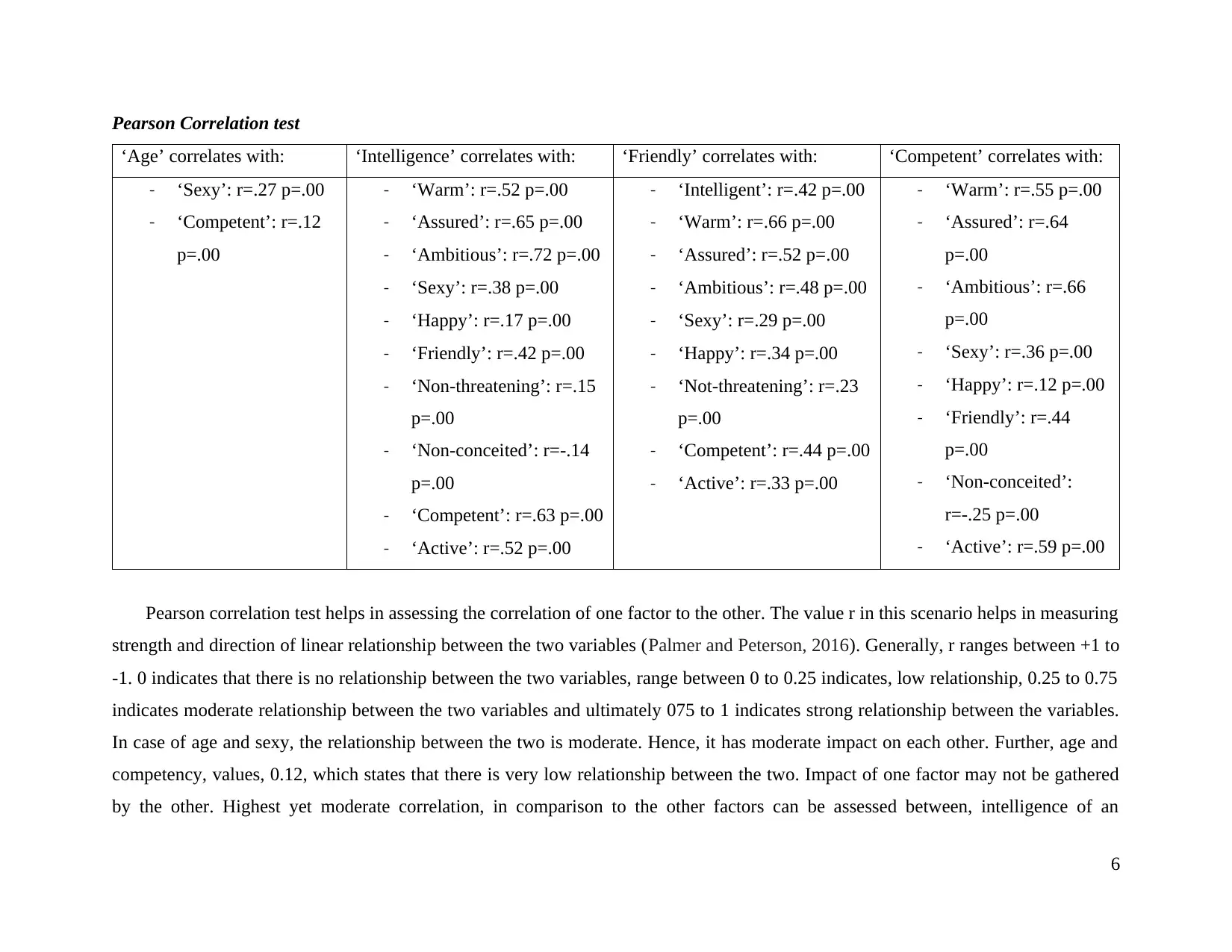
Pearson Correlation test
‘Age’ correlates with: ‘Intelligence’ correlates with: ‘Friendly’ correlates with: ‘Competent’ correlates with:
- ‘Sexy’: r=.27 p=.00
- ‘Competent’: r=.12
p=.00
- ‘Warm’: r=.52 p=.00
- ‘Assured’: r=.65 p=.00
- ‘Ambitious’: r=.72 p=.00
- ‘Sexy’: r=.38 p=.00
- ‘Happy’: r=.17 p=.00
- ‘Friendly’: r=.42 p=.00
- ‘Non-threatening’: r=.15
p=.00
- ‘Non-conceited’: r=-.14
p=.00
- ‘Competent’: r=.63 p=.00
- ‘Active’: r=.52 p=.00
- ‘Intelligent’: r=.42 p=.00
- ‘Warm’: r=.66 p=.00
- ‘Assured’: r=.52 p=.00
- ‘Ambitious’: r=.48 p=.00
- ‘Sexy’: r=.29 p=.00
- ‘Happy’: r=.34 p=.00
- ‘Not-threatening’: r=.23
p=.00
- ‘Competent’: r=.44 p=.00
- ‘Active’: r=.33 p=.00
- ‘Warm’: r=.55 p=.00
- ‘Assured’: r=.64
p=.00
- ‘Ambitious’: r=.66
p=.00
- ‘Sexy’: r=.36 p=.00
- ‘Happy’: r=.12 p=.00
- ‘Friendly’: r=.44
p=.00
- ‘Non-conceited’:
r=-.25 p=.00
- ‘Active’: r=.59 p=.00
Pearson correlation test helps in assessing the correlation of one factor to the other. The value r in this scenario helps in measuring
strength and direction of linear relationship between the two variables (Palmer and Peterson, 2016). Generally, r ranges between +1 to
-1. 0 indicates that there is no relationship between the two variables, range between 0 to 0.25 indicates, low relationship, 0.25 to 0.75
indicates moderate relationship between the two variables and ultimately 075 to 1 indicates strong relationship between the variables.
In case of age and sexy, the relationship between the two is moderate. Hence, it has moderate impact on each other. Further, age and
competency, values, 0.12, which states that there is very low relationship between the two. Impact of one factor may not be gathered
by the other. Highest yet moderate correlation, in comparison to the other factors can be assessed between, intelligence of an
6
‘Age’ correlates with: ‘Intelligence’ correlates with: ‘Friendly’ correlates with: ‘Competent’ correlates with:
- ‘Sexy’: r=.27 p=.00
- ‘Competent’: r=.12
p=.00
- ‘Warm’: r=.52 p=.00
- ‘Assured’: r=.65 p=.00
- ‘Ambitious’: r=.72 p=.00
- ‘Sexy’: r=.38 p=.00
- ‘Happy’: r=.17 p=.00
- ‘Friendly’: r=.42 p=.00
- ‘Non-threatening’: r=.15
p=.00
- ‘Non-conceited’: r=-.14
p=.00
- ‘Competent’: r=.63 p=.00
- ‘Active’: r=.52 p=.00
- ‘Intelligent’: r=.42 p=.00
- ‘Warm’: r=.66 p=.00
- ‘Assured’: r=.52 p=.00
- ‘Ambitious’: r=.48 p=.00
- ‘Sexy’: r=.29 p=.00
- ‘Happy’: r=.34 p=.00
- ‘Not-threatening’: r=.23
p=.00
- ‘Competent’: r=.44 p=.00
- ‘Active’: r=.33 p=.00
- ‘Warm’: r=.55 p=.00
- ‘Assured’: r=.64
p=.00
- ‘Ambitious’: r=.66
p=.00
- ‘Sexy’: r=.36 p=.00
- ‘Happy’: r=.12 p=.00
- ‘Friendly’: r=.44
p=.00
- ‘Non-conceited’:
r=-.25 p=.00
- ‘Active’: r=.59 p=.00
Pearson correlation test helps in assessing the correlation of one factor to the other. The value r in this scenario helps in measuring
strength and direction of linear relationship between the two variables (Palmer and Peterson, 2016). Generally, r ranges between +1 to
-1. 0 indicates that there is no relationship between the two variables, range between 0 to 0.25 indicates, low relationship, 0.25 to 0.75
indicates moderate relationship between the two variables and ultimately 075 to 1 indicates strong relationship between the variables.
In case of age and sexy, the relationship between the two is moderate. Hence, it has moderate impact on each other. Further, age and
competency, values, 0.12, which states that there is very low relationship between the two. Impact of one factor may not be gathered
by the other. Highest yet moderate correlation, in comparison to the other factors can be assessed between, intelligence of an
6
⊘ This is a preview!⊘
Do you want full access?
Subscribe today to unlock all pages.

Trusted by 1+ million students worldwide
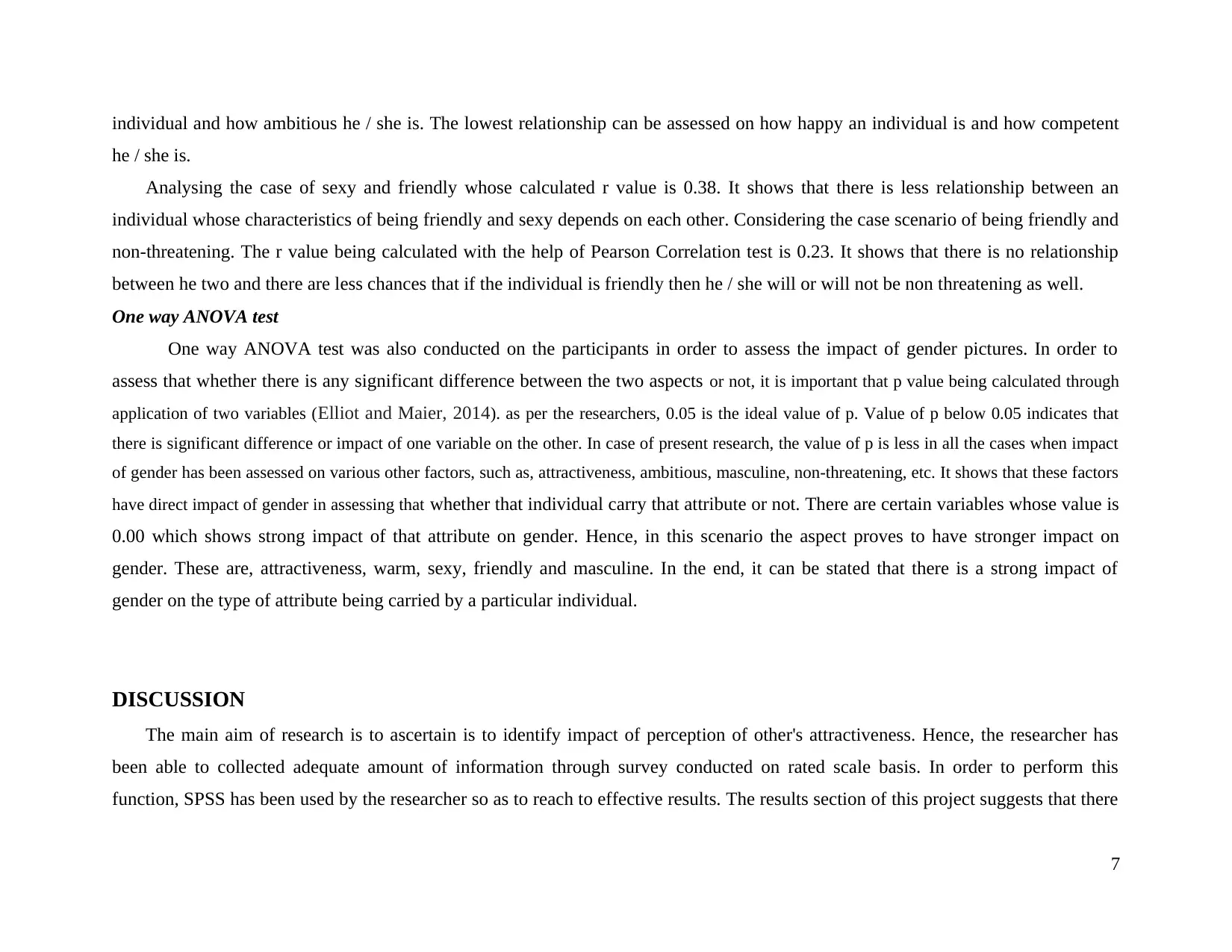
individual and how ambitious he / she is. The lowest relationship can be assessed on how happy an individual is and how competent
he / she is.
Analysing the case of sexy and friendly whose calculated r value is 0.38. It shows that there is less relationship between an
individual whose characteristics of being friendly and sexy depends on each other. Considering the case scenario of being friendly and
non-threatening. The r value being calculated with the help of Pearson Correlation test is 0.23. It shows that there is no relationship
between he two and there are less chances that if the individual is friendly then he / she will or will not be non threatening as well.
One way ANOVA test
One way ANOVA test was also conducted on the participants in order to assess the impact of gender pictures. In order to
assess that whether there is any significant difference between the two aspects or not, it is important that p value being calculated through
application of two variables (Elliot and Maier, 2014). as per the researchers, 0.05 is the ideal value of p. Value of p below 0.05 indicates that
there is significant difference or impact of one variable on the other. In case of present research, the value of p is less in all the cases when impact
of gender has been assessed on various other factors, such as, attractiveness, ambitious, masculine, non-threatening, etc. It shows that these factors
have direct impact of gender in assessing that whether that individual carry that attribute or not. There are certain variables whose value is
0.00 which shows strong impact of that attribute on gender. Hence, in this scenario the aspect proves to have stronger impact on
gender. These are, attractiveness, warm, sexy, friendly and masculine. In the end, it can be stated that there is a strong impact of
gender on the type of attribute being carried by a particular individual.
DISCUSSION
The main aim of research is to ascertain is to identify impact of perception of other's attractiveness. Hence, the researcher has
been able to collected adequate amount of information through survey conducted on rated scale basis. In order to perform this
function, SPSS has been used by the researcher so as to reach to effective results. The results section of this project suggests that there
7
he / she is.
Analysing the case of sexy and friendly whose calculated r value is 0.38. It shows that there is less relationship between an
individual whose characteristics of being friendly and sexy depends on each other. Considering the case scenario of being friendly and
non-threatening. The r value being calculated with the help of Pearson Correlation test is 0.23. It shows that there is no relationship
between he two and there are less chances that if the individual is friendly then he / she will or will not be non threatening as well.
One way ANOVA test
One way ANOVA test was also conducted on the participants in order to assess the impact of gender pictures. In order to
assess that whether there is any significant difference between the two aspects or not, it is important that p value being calculated through
application of two variables (Elliot and Maier, 2014). as per the researchers, 0.05 is the ideal value of p. Value of p below 0.05 indicates that
there is significant difference or impact of one variable on the other. In case of present research, the value of p is less in all the cases when impact
of gender has been assessed on various other factors, such as, attractiveness, ambitious, masculine, non-threatening, etc. It shows that these factors
have direct impact of gender in assessing that whether that individual carry that attribute or not. There are certain variables whose value is
0.00 which shows strong impact of that attribute on gender. Hence, in this scenario the aspect proves to have stronger impact on
gender. These are, attractiveness, warm, sexy, friendly and masculine. In the end, it can be stated that there is a strong impact of
gender on the type of attribute being carried by a particular individual.
DISCUSSION
The main aim of research is to ascertain is to identify impact of perception of other's attractiveness. Hence, the researcher has
been able to collected adequate amount of information through survey conducted on rated scale basis. In order to perform this
function, SPSS has been used by the researcher so as to reach to effective results. The results section of this project suggests that there
7
Paraphrase This Document
Need a fresh take? Get an instant paraphrase of this document with our AI Paraphraser
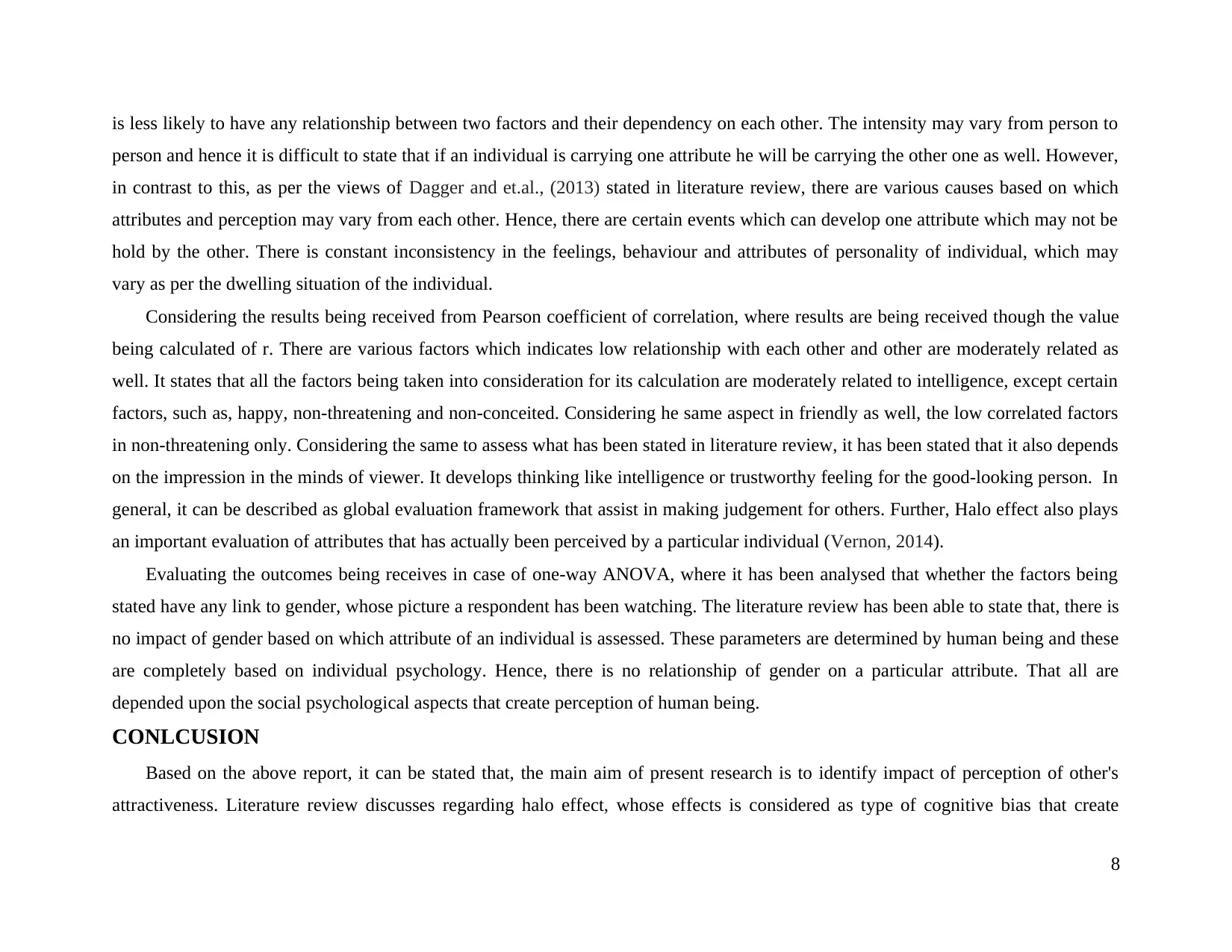
is less likely to have any relationship between two factors and their dependency on each other. The intensity may vary from person to
person and hence it is difficult to state that if an individual is carrying one attribute he will be carrying the other one as well. However,
in contrast to this, as per the views of Dagger and et.al., (2013) stated in literature review, there are various causes based on which
attributes and perception may vary from each other. Hence, there are certain events which can develop one attribute which may not be
hold by the other. There is constant inconsistency in the feelings, behaviour and attributes of personality of individual, which may
vary as per the dwelling situation of the individual.
Considering the results being received from Pearson coefficient of correlation, where results are being received though the value
being calculated of r. There are various factors which indicates low relationship with each other and other are moderately related as
well. It states that all the factors being taken into consideration for its calculation are moderately related to intelligence, except certain
factors, such as, happy, non-threatening and non-conceited. Considering he same aspect in friendly as well, the low correlated factors
in non-threatening only. Considering the same to assess what has been stated in literature review, it has been stated that it also depends
on the impression in the minds of viewer. It develops thinking like intelligence or trustworthy feeling for the good-looking person. In
general, it can be described as global evaluation framework that assist in making judgement for others. Further, Halo effect also plays
an important evaluation of attributes that has actually been perceived by a particular individual (Vernon, 2014).
Evaluating the outcomes being receives in case of one-way ANOVA, where it has been analysed that whether the factors being
stated have any link to gender, whose picture a respondent has been watching. The literature review has been able to state that, there is
no impact of gender based on which attribute of an individual is assessed. These parameters are determined by human being and these
are completely based on individual psychology. Hence, there is no relationship of gender on a particular attribute. That all are
depended upon the social psychological aspects that create perception of human being.
CONLCUSION
Based on the above report, it can be stated that, the main aim of present research is to identify impact of perception of other's
attractiveness. Literature review discusses regarding halo effect, whose effects is considered as type of cognitive bias that create
8
person and hence it is difficult to state that if an individual is carrying one attribute he will be carrying the other one as well. However,
in contrast to this, as per the views of Dagger and et.al., (2013) stated in literature review, there are various causes based on which
attributes and perception may vary from each other. Hence, there are certain events which can develop one attribute which may not be
hold by the other. There is constant inconsistency in the feelings, behaviour and attributes of personality of individual, which may
vary as per the dwelling situation of the individual.
Considering the results being received from Pearson coefficient of correlation, where results are being received though the value
being calculated of r. There are various factors which indicates low relationship with each other and other are moderately related as
well. It states that all the factors being taken into consideration for its calculation are moderately related to intelligence, except certain
factors, such as, happy, non-threatening and non-conceited. Considering he same aspect in friendly as well, the low correlated factors
in non-threatening only. Considering the same to assess what has been stated in literature review, it has been stated that it also depends
on the impression in the minds of viewer. It develops thinking like intelligence or trustworthy feeling for the good-looking person. In
general, it can be described as global evaluation framework that assist in making judgement for others. Further, Halo effect also plays
an important evaluation of attributes that has actually been perceived by a particular individual (Vernon, 2014).
Evaluating the outcomes being receives in case of one-way ANOVA, where it has been analysed that whether the factors being
stated have any link to gender, whose picture a respondent has been watching. The literature review has been able to state that, there is
no impact of gender based on which attribute of an individual is assessed. These parameters are determined by human being and these
are completely based on individual psychology. Hence, there is no relationship of gender on a particular attribute. That all are
depended upon the social psychological aspects that create perception of human being.
CONLCUSION
Based on the above report, it can be stated that, the main aim of present research is to identify impact of perception of other's
attractiveness. Literature review discusses regarding halo effect, whose effects is considered as type of cognitive bias that create
8
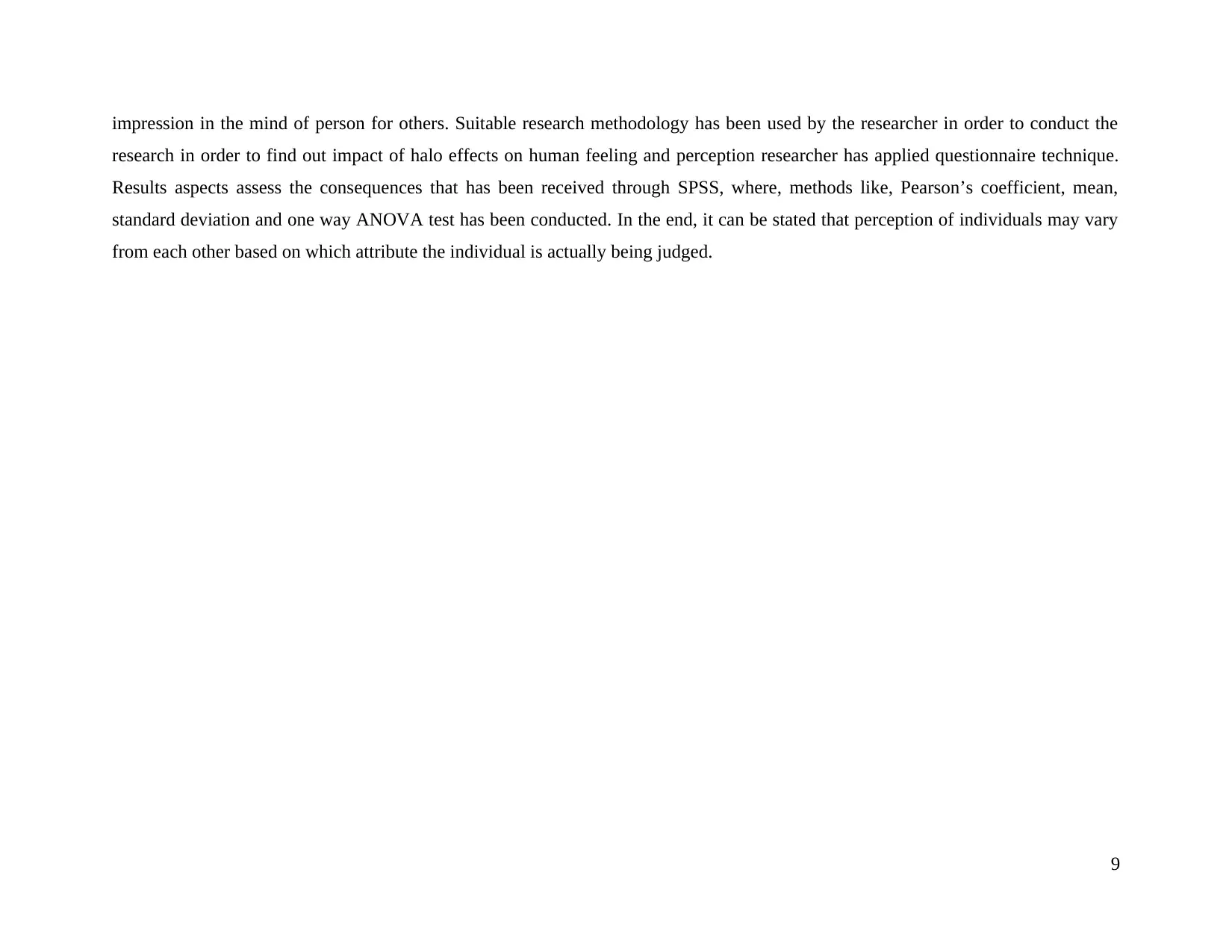
impression in the mind of person for others. Suitable research methodology has been used by the researcher in order to conduct the
research in order to find out impact of halo effects on human feeling and perception researcher has applied questionnaire technique.
Results aspects assess the consequences that has been received through SPSS, where, methods like, Pearson’s coefficient, mean,
standard deviation and one way ANOVA test has been conducted. In the end, it can be stated that perception of individuals may vary
from each other based on which attribute the individual is actually being judged.
9
research in order to find out impact of halo effects on human feeling and perception researcher has applied questionnaire technique.
Results aspects assess the consequences that has been received through SPSS, where, methods like, Pearson’s coefficient, mean,
standard deviation and one way ANOVA test has been conducted. In the end, it can be stated that perception of individuals may vary
from each other based on which attribute the individual is actually being judged.
9
⊘ This is a preview!⊘
Do you want full access?
Subscribe today to unlock all pages.

Trusted by 1+ million students worldwide
1 out of 14
Related Documents
Your All-in-One AI-Powered Toolkit for Academic Success.
+13062052269
info@desklib.com
Available 24*7 on WhatsApp / Email
![[object Object]](/_next/static/media/star-bottom.7253800d.svg)
Unlock your academic potential
Copyright © 2020–2025 A2Z Services. All Rights Reserved. Developed and managed by ZUCOL.





